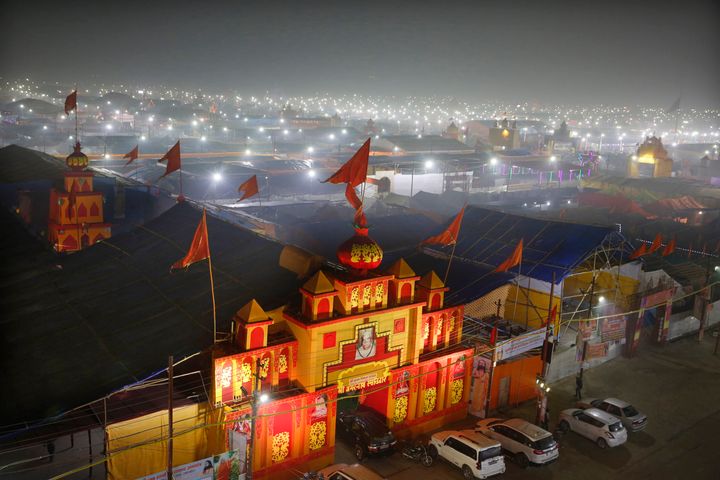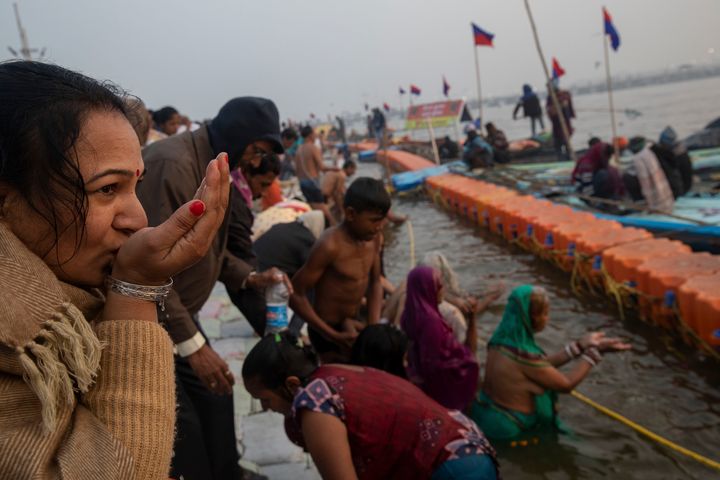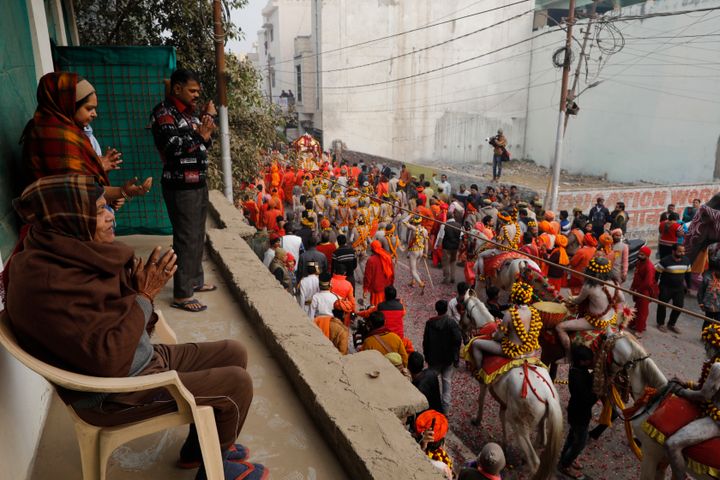
PRAYAGRAJ — Pilgrims from across the world are gathering for the Kumbh Mela, a mix of spirituality, politics and tourism that began on Tuesday. Thousands of portable toilets lined roads constantly swept clean, drinking water flows from newly installed taps, electric substations power a massive tent city and billboards encourage a “clean Kumbh”.
But the skies over the confluence of sacred rivers in northern India where millions of Hindu priests and pilgrims have come to wash away their sins at the festival are thick with toxic dust, a sign that government officials are struggling to grapple with the country’s worsening air pollution.
The hazardous air may also hinder the government’s drive to make the Kumbh Mela, or pitcher festival, a global tourism event.
During the eight-week festival at Allahabad, recently renamed Prayagraj, in Uttar Pradesh, authorities expect up to 150 million people, including a million foreign visitors, to bathe at the confluence of the Ganga, the Yamuna, and a mythical third river, the Saraswati.
Devout Hindus believe that bathing in the waters of the Ganga absolves people of sins and bathing at the time of the Kumbh Mela, or the “festival of the pot”, brings salvation from the cycle of life and death.
The first of a series of royal baths took place before dawn on Tuesday, led by a procession of sadhus on tractor chariots and on foot, singing, drumming and blowing horns. The first to bathe were the naga sadhus, whose bodies were covered with ash. Huge crowds followed them into the river, including Mili Mishra, a teacher from Prayagraj with her husband and two sons.
“We are not earning a livelihood. We think that if we bathe here, God can change our life,” she said.
The exact dates and times of the baths, as well as the Kumbh itself, are determined by the cosmic alignment of the sun, moon and Jupiter.

The government has for years provided security and free food and shelter for the poorest pilgrims.
For this year’s Kumbh — though less religiously significant than the Kumbh that happens every 12 years, and still less than the one that occurs every 144 years — the government shelled out an estimated Rs 4.3 billion ($650 million).
The budget supplied thousands of toilets and urinals, public dormitories, and hundreds of water stations, as well as police, hospitals, 24-hour pharmacies and fire and ambulance services.
The expansive campgrounds hosted everything from luxury “glamping” options that cost up to Rs 35,000 ($494) per night — private, tent “suites” with plush bedding and flush toilets — to a cot with a thin foam mattress in a public dormitory in a high-top tent that costs Rs 200 ($2.83) per night.
“I go to holy sites very often, but I’m used to them being very dirty. I have never seen this level of cleanliness measures at any other holy city,” said Gita Mishra, 58, one of the guests at a public tent near the banks of the river.
When people waiting for a spot outside the tent learned it was full, they laid blankets around the periphery to sleep in the hazy open air.
Still others, including about 500 sanitation workers, pitched pup tents near a row of some of the toilets they are paid Rs 300 ($7) per day to clean.
The production of any Kumbh is a gargantuan task, particularly in the low-lying Indian army parade grounds in Prayagraj where the ritual baths take place. Regular summertime floods leave organisers only 40 to 50 days to erect the temporary city, according to city commissioner Ashish Goel.
But this year’s public provisions are unprecedented.
“It’s a very aspirational Kumbh Mela,” Goel said.

The dust plumes encompassing the camp come from the sandy riverbanks, Goel said, and not from construction, which is banned during the 55-day festival. Still, in the city center outside of the fairgrounds, brick kilns send up clouds of PM 2.5, tiny particulate matter that can dangerously clog lungs.
Even with the construction ban, PM 2.5 levels in Prayagraj on Tuesday were more than six times what the World Health Organization considers safe, according to AQI India, an online air quality monitor.
India’s cities are among the world’s smoggiest.
The government has announced a five-year program to cut air pollution by up to 30 percent from 2017 levels in the country’s 102 worst-affected cities, including Prayagraj.
Key targets include reducing burning of field waste, firewood and charcoal, cleaning up thermal power and auto emissions and heavily polluting brick production and controlling dust from construction.
Critics say the plan lacks details on enforcement and funding.
Political pilgrimage
This year’s event comes at a critical time for Modi’s Bharatiya Janata Party (BJP), expected to face a tough contest in a general election due by May.
It lost power in three key states in assembly elections in December, and will want to avoid a similar result during the general election in Uttar Pradesh, a state of 220 million where a good showing can often decide the outcome.
Modi and opposition Congress leader Rahul Gandhi are both expected to attend the festival before it wraps up in March.
(With inputs from Reuters and AP)